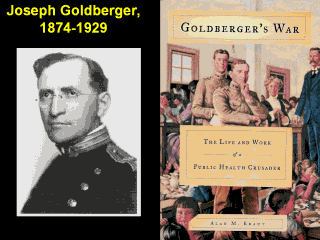 |
Joseph
Goldberger, a medical epidemiologist employed by the United States’ Public
Health Service, had observed that while inmates of total institutions, such
as asylums and prisons, had high rates of pellagra, the custodial staff did
not. This implied to Goldberger that pellagra was not contagious. He, in
fact, correctly attributed this disease to a dietary deficiency, which could
be prevented with a diet of meat, fresh vegetables, and milk. Goldberger
died in 1929, and it was only in 1937 that the specific deficiency was
isolated – a deficiency in niacin, a member of the Vitamin B family.
Nevertheless, prevention of pellagra did not have to await this very
specific discovery. Goldberger’s War, an historical biography
published in 2003, recounts the remarkable life of a true hero in
epidemiology and American history. In the course of
his vigorous and rigorous pursuit of disease understanding, Goldberger
became afflicted with three potentially life-threatening communicable
diseases; typhus fever, yellow fever, and dengue fever. A noncommunicable
disease, cancer, aggressively and prematurely ended his life.
|
